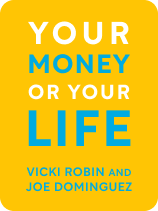

This article is an excerpt from the Shortform book guide to "Your Money or Your Life" by Vicki Robin and Joe Dominguez. Shortform has the world's best summaries and analyses of books you should be reading.
Like this article? Sign up for a free trial here .
What do you consider to be money well spent? What standard do you use to evaluate your personal spending?
In Your Money or Your Life, Vicki Robin and Joe Dominguez offer four questions to ask yourself about your expenditures. The questions seek to determine what is money well spent for you. Ultimately, this can help you make better personal spending decisions.
Read more to learn how to figure out what is money well spent in your life.
Determine What Is Money Well Spent
When you have a sense of your values, purpose, and dreams, you can use them as benchmarks to evaluate your spending. You can get a better sense of what, exactly, is money well spent in your life.
If you haven’t already done so, develop spending categories and subcategories that capture what you spend money on each month. For example, let’s say one of your spending categories is “Food.” If you realize that you’re frequently buying vending machine snacks in your office building, include “vending machine snacks” as a subcategory of “Food.”
Next, ask yourself the following questions for each category and subcategory of spending.
Question 1: Is the Amount of Happiness and Contentment I Got From These Purchases Worth the Life Energy I Spent?
Ideally, the more money you spend, the more enjoyment you should get. But it’s common to spend money that doesn’t bring adequate fulfillment for the expense. Question 1 helps identify areas where you’re overspending relative to your enjoyment. On the flip side, it helps you see spending categories that bring great joy to your life that you could spend more money on. You’ll start to map the intersection between spending and fulfillment—what’s enough (money well spent) for you.
Look at each subcategory and category of your spreadsheet, and assign one of three symbols in the first column for each:
- Use a “-” sign if you didn’t get fulfillment proportional to what you spent and should spend less.
- Use a “+” sign if you got fulfillment proportional to what you spent and think you should spend more.
- Use a “0” if you got fulfillment proportional to what you spent and think your spending should stay the same.
- For example, you ask Question 1 looking at the $50 you spent on magazine subscriptions in the past month and realize that most of those magazines regularly go unread. Because you don’t enjoy them in proportion to their cost, you mark a “-” in the first column, indicating that you can spend less.
Do this as objectively as you can without thinking too hard about the amount you spent. This will help you evaluate the subcategory purely from an enjoyment perspective without passing judgment.
Asking monthly whether your spending brought you fulfillment will calibrate you to your “enough”—the intersection of your spending with fulfillment. Learning what your “enough” is rather than relying on external sources for fulfillment is a major component of determining what is money well spent and making sure your spending leads to happiness.
Question 2: Is Spending This Amount of Life Energy Consistent With My Values and Purpose?
Next, you’ll examine your spending in each subcategory and category through the lens of your values and purpose.
Look at the next blank column, to the right of the column you used for Question 1. In this column, follow the same procedure as before, using “-”, “+”, and “0” to show when spending less money, more money, or the same amount is necessary to bring each particular category and subcategory in line with your values and life purpose.
For example, you spent about $25 dollars each week on lunches from chain restaurants and $16 on lunches from locally-owned businesses. You’re comfortable with the total amount spent, but you’d prefer that the majority of the lunch money go to locally-owned businesses because you value keeping wealth in the local community. To reflect this, you mark a “-” for the chain restaurants subcategory, and a “+” for the local businesses subcategory.
Question 3: If I Didn’t Have to Work for Money, Would I Spend More, Less, or the Same Amount of Life Energy?
Consider how you might spend your time if you didn’t have to work for money. Then, go one step further. Consider how you would spend your life energy (money) differently if you didn’t have to work for money.
Working often requires that we spend money on things like commuting. Asking Question 3 for each subcategory and category illuminates how much of your spending is due to work and work-related activities.
You may find that life would be cheaper if you didn’t have to work. For example, maybe you’d stop spending money on your fancy work wardrobe. But you might spend more in certain categories, like travel.
There are no right or wrong answers. The point is to imagine how your spending would look different under a different set of circumstances. Since you’re working toward financial independence—not having to work for money—this will ultimately help you plan for life once you’re financially independent.
In the next blank column, to the right of the column you used for Question 2, follow the same procedure as before, marking a “-”, “+”, and “0” to show how you think your expenses in each of these categories would change.
Question 4: In a World Where Everyone Could Meet Their Basic Needs and Had Enough, How Would My Spending in This Category Change?
We over-consume material goods. If everyone in the world did this, we’d quickly deplete the earth’s resources. To interrupt this tendency, ask this fourth question to determine whether spending in each of your subcategories aligns with people around the world having enough to meet their needs now, and in the future.
This question brings another dimension to the idea of money well spent. Tailor it to make it compelling to you. Here are four examples of ways to rephrase it:
- If everyone spent like this, would the world be a better place?
- Is this good for the environment/Earth/others?
- What would Jesus do?
- If everyone in the world were this mindful about how they spent their life energy, would it change the world?
Spotting Patterns and Making Adjustments
Once you’ve gone through each question with each of your subcategories and categories, the next step is to return to each subcategory to reflect.
Evaluating your subcategories according to each question may make clear the areas to adjust. For example, if you marked a minus indicating that you didn’t derive enough enjoyment from what you spent on movies, and you marked a minus indicating it didn’t align with your values and purpose, this is a sign you should adjust your spending in that category.
Again, try to do this as objectively as possible, and go easy on yourself. Ultimately, the goal is to adjust your spending so that you only have 0s (“I’m spending exactly what I want to spend in this category”) or pluses (“Spending life energy in this category brings me great fulfillment in proportion to what I spend, and spending even more will bring me even greater happiness.”)
This process allows you to redirect or eliminate excess personal spending and get closer to your “enough.” Now you have a better sense of what constitutes money well spent in your life.

———End of Preview———
Like what you just read? Read the rest of the world's best book summary and analysis of Vicki Robin and Joe Dominguez's "Your Money or Your Life" at Shortform .
Here's what you'll find in our full Your Money or Your Life summary :
- The 9 steps to reach financial independence
- How to change your entire relationship with money and live a more meaningful life
- How to align your spending habits with your values, purpose, and dreams






